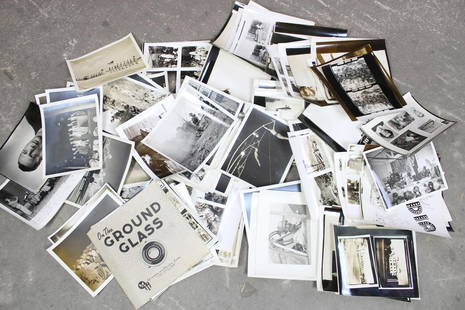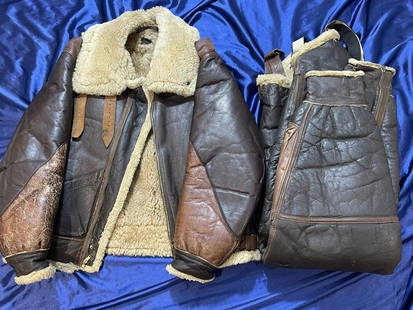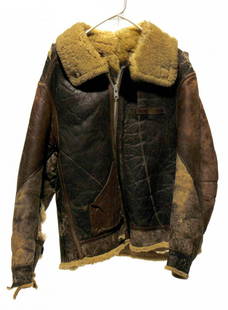
WWII US ARMY AIR CORPS B-15 NAMED FLIGHT JACKET
Similar Sale History
View More Items in Militaria & War Memorabilia

Related Militaria & War Memorabilia
More Items in Militaria & War Memorabilia
View MoreRecommended Collectibles
View More






Item Details
Description
Olive color cotton fabric type B-15A jacket with fur collar and fur-lined, front "CONMAR" zip fastener with leather pull tab. Two slant side pockets with press button closure, left sleeve pencil patch pocket. Fur collar closure with fur covered strap and two buttons. Post War name plate and squadron patch with a spectacular history of a famed photographer who's history spanned from post WWII into Vietnam.. His name was Gene Furnish who's littered with Photo credits on Google. His major claim to fame was photographing the Operation Crossroads Atomic Bomb photos as well as the first Supersonic flight flown by Capt. Charles E. "Chuck" Yeager and the plane was the Bell X-1 Glamorous Glennis named after Chuck's wife. There are also several exploits of his photography including his parachuting from a plane to get a particular shot of passing planes and several shots of SR-71 Blackbird shots in flight. The squadron patch says Aerial Photographer AFFTC Edwards AFB Per Oculos Ad Astra. A very unique named Flight Jacket with Stellar History. Jacket is roughly a size 40. Operation Crossroads was a pair of nuclear weapon tests conducted by the United States at Bikini Atoll in mid-1946. They were the first nuclear weapon tests since Trinity on July 16, 1945, and the first detonations of nuclear devices since the atomic bombing of Nagasaki on August 9, 1945. The purpose of the tests was to investigate the effect of nuclear weapons on warships. The Crossroads tests were the first of many nuclear tests held in the Marshall Islands, and the first to be publicly announced beforehand and observed by an invited audience, including a large press corps. They were conducted by Joint Army/Navy Task Force One, headed by Vice Admiral William H. P. Blandy rather than by the Manhattan Project, which had developed nuclear weapons during World War II. A fleet of 95 target ships was assembled in Bikini Lagoon and hit with two detonations of Fat Man plutonium implosion-type nuclear weapons of the kind dropped on Nagasaki in 1945, each with a yield of 23 kilotons of TNT (96 TJ). The first test was Able. The bomb was named Gilda after Rita Hayworth's character in the 1946 film Gilda, and was dropped from the B-29 Superfortress Dave's Dream of the 509th Bombardment Group on July 1, 1946. It detonated 520 feet (158 m) above the target fleet and caused less than the expected amount of ship damage because it missed its aim point by 2,130 feet (649 m). The second test was Baker. The bomb was known as Helen of Bikini and was detonated 90 feet (27 m) underwater on July 25, 1946. Radioactive sea spray caused extensive contamination. A third deep-water test named Charlie was planned for 1947 but was canceled primarily because of the United States Navy's inability to decontaminate the target ships after the Baker test. Ultimately, only nine target ships were able to be scrapped rather than scuttled. Charlie was rescheduled as Operation Wigwam, a deep-water shot conducted in 1955 off the coast of Mexico (Baja California). Bikini's native residents were evacuated from the island on board the LST-861, with most moving to the Rongerik Atoll. In the 1950s, a series of large thermonuclear tests rendered Bikini unfit for subsistence farming and fishing because of radioactive contamination. Bikini remains uninhabited as of 2017, though it is occasionally visited by sport divers. Planners attempted to protect participants in the Operation Crossroads tests against radiation sickness, but one study showed that the life expectancy of participants was reduced by an average of three months. The Baker test's radioactive contamination of all the target ships was the first case of immediate, concentrated radioactive fallout from a nuclear explosion. Chemist Glenn T. Seaborg, the longest-serving chairman of the Atomic Energy Commission, called Baker "the world's first nuclear disaster."On October 14, 1947, the Bell X-1 became the first airplane to fly faster than the speed of sound. Piloted by U.S. Air Force Capt. Charles E. "Chuck" Yeager, the X-1 reached a speed of 1,127 kilometers (700 miles) per hour, Mach 1.06, at an altitude of 13,000 meters (43,000 feet). Yeager named the airplane "Glamorous Glennis" in tribute to his wife. Air-launched at an altitude of 7,000 meters (23,000 feet) from the bomb bay of a Boeing B-29, the X-1 used its rocket engine to climb to its test altitude. It flew a total of 78 times, and on March 26, 1948, with Yeager at the controls, it attained a speed of 1,540 kilometers (957 miles) per hour, Mach 1.45, at an altitude of 21,900 meters (71,900 feet). This was the highest velocity and altitude reached by a manned airplane up to that time.
Buyer's Premium
- 20%
WWII US ARMY AIR CORPS B-15 NAMED FLIGHT JACKET
Estimate $600 - $1,000
14 bidders are watching this item.
Shipping & Pickup Options
Item located in Willoughby, OH, usOffers In-House Shipping
Local Pickup Available
Payment

Related Searches
TOP

























































![George Washington Signed Discharge: Partly printed discharge document signed by George Washington, as Commander in Chief of the Armies of the United States. Newburgh, [New York], 4 January 1783. 1 page, ## x ## in. Undersigned by Washin](https://p1.liveauctioneers.com/7226/322253/173251475_1_x.jpg?height=310&quality=70&version=1710004847)
![[Ambrotype] Texas Confederate Soldier: Sixth plate ambrotype. Full leatherette case. Portrait of a possible Texas Confederate soldier. A silver star device was used to pin up the brim of his light-toned headgear, a look often seen in image](https://p1.liveauctioneers.com/7226/322253/173251509_1_x.jpg?height=310&quality=70&version=1710004847)
![Captured Bowie Knife w/ Period Note of Provenance: Captured Confederate D-hilt Bowie knife. [Kenansville, North Carolina]: [Louis Froelich factory]. With original metal and leather sheath with affixed period notes. First note with only remnants. Secon](https://p1.liveauctioneers.com/7226/325455/175169154_1_x.jpg?height=310&quality=70&version=1712370394)
![[Civil War] Bullet Which Nearly Killed Soldier: Lead bullet encased in gold acorn fob with chain. Finely engraved: "W.D. Fiske / 14th Regt. C V / Fredericksburg / Dec 17, 1863." Acorn approx. 1 1/2 x 1 in. Overall length 6 1/2 in. Published in "Her](https://p1.liveauctioneers.com/7226/325455/175169103_1_x.jpg?height=310&quality=70&version=1712370394)


![[CIVIL WAR] 1st Texas Infantry in Camp: Outdoor half plate ambrotype of the 1st Texas Infantry. Full leatherette case. Significant, large half plate ambrotype of members of the 1st Texas Infantry at ‘Splinterville,’ the regiment’s win](https://p1.liveauctioneers.com/7226/322253/173251512_1_x.jpg?height=310&quality=70&version=1710004847)
![[HANCOCK, John] Washington’s Spy, Officer’s Commission: Partly printed document signed by John Hancock as President of the Continental Congress, for Epaphras Bull (1748-1781). [Philadelphia, Pennsylvania], 10 January 1777. 1 page, ## x ## in. Completed in](https://p1.liveauctioneers.com/7226/322253/173251471_1_x.jpg?height=310&quality=70&version=1710004847)
![[CIVIL WAR] Black Soldier & Wife: CDV-sized tintype photograph WITH gem-sized tintype. Full thermoplastic case. Portrait of an unknown African American Civil War soldier who holds the rank of sergeant. He looks directly at the camera](https://p1.liveauctioneers.com/7226/322253/173251671_1_x.jpg?height=310&quality=70&version=1710004847)
![Historic Einstein Signed Program from Lincoln University Visit: Conferences on Objectives. Lincoln University, [Oxford], Pennsylvania, 3 May 1946. SIGNED BY ALBERT EINSTEIN. Tipped into Horace Mann Bond (1904-1972). The Education of the Negro in the American Socia](https://p1.liveauctioneers.com/7226/322253/173251693_1_x.jpg?height=310&quality=70&version=1710004847)
![[Civil War] Cavalry Regiment's Colors : Regulation Civil War Cavalry Regimental flag, c. 1861-1865. Hand-painted and gilded on silk. Approx. 34 x 31 inches. Trimmed on three sides with gold silk fringe. Extremely fine Federal regulation han](https://p1.liveauctioneers.com/7226/325455/175169108_1_x.jpg?height=310&quality=70&version=1712370394)







